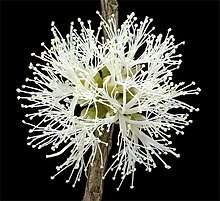Melaleuca undulata
Melaleuca undulata, commonly known as hidden honey-myrtle is a shrub in the myrtle family Myrtaceae and is endemic to the south of Western Australia. It is a spreading, moderately dense, perennial, woody shrub with creamy-white flowers in small clusters.
| Hidden honey-myrtle | |
|---|---|
 | |
| Scientific classification | |
| Kingdom: | Plantae |
| Clade: | Tracheophytes |
| Clade: | Angiosperms |
| Clade: | Eudicots |
| Clade: | Rosids |
| Order: | Myrtales |
| Family: | Myrtaceae |
| Genus: | Melaleuca |
| Species: | M. undulata |
| Binomial name | |
| Melaleuca undulata | |
Description
Melaleuca undulata grows to a height of about 0.3–2 m (1–7 ft) spreading to 2 m (7 ft) or more. Its leaves are arranged alternately, mostly lance-shaped to oval, 3–15 mm (0.1–0.6 in) long and 1.5–4 mm (0.06–0.2 in) wide and slightly hairy.
The flowers are arranged in heads up to 27 mm (1 in) in diameter scattered along the branches, with 1 to 18 flowers in each head. The flowers mainly appear from October to March and are white to cream. The stamens are arranged in bundles of five around the flower, with 8 to 30 stamens in each bundle. The base of the flower is glabrous and 1.2–2.5 mm (0.05–0.1 in) long. The woody capsules are 2.5–4 mm (0.1–0.2 in) long.[2][3]
Taxonomy and naming
Melaleuca undulata was first formally described in 1867 by George Bentham in Flora Australiensis.[1][4] The specific epithet (undulata) is derived from the Latin undulatus meaning "wavy"[5] "in reference to the leaf blade being wavy".[3]
Distribution and habitat
This melaleuca occurs from the Stirling Range – Broomehill district eastwards to the Israelite Bay district. It grows in mallee and heath, in swampy and areas, river beds and edge of clay pans in sand, clay on laterite gravel.[3]
Conservation
Melaleuca undulata is classified as "not threatened" by the Government of Western Australia Department of Parks and Wildlife.[6]
Use in horticulture
This is a hardy species suitable as a low, informal, prickly hedge. It will grow in most soils and aspects.[7]
References
- "Melaleuca undulata". APNI. Retrieved 14 March 2015.
- Holliday, Ivan (2004). Melaleucas : a field and garden guide (2nd ed.). Frenchs Forest, N.S.W.: Reed New Holland Publishers. p. 70. ISBN 1876334983.
- Brophy, Joseph J.; Craven, Lyndley A.; Doran, John C. (2013). Melaleucas : their botany, essential oils and uses. Canberra: Australian Centre for International Agricultural Research. p. 373. ISBN 9781922137517.
- Mueller, Ferdinand (1866). Flora Australiensis, volume 3. London. p. 154. Retrieved 14 March 2015.
- Brown, Roland Wilbur (1956). The Composition of Scientific Words. Washington, D.C.: Smithsonian Institution Press. p. 826.
- "Melaleuca undulata". FloraBase. Western Australian Government Department of Parks and Wildlife.
- Wrigley, John; Fagg, Murray (1983). Australian native plants : a manual for their propagation, cultivation and use in landscaping (2nd ed.). Sydney: Collins. pp. 270–271. ISBN 0002165759.